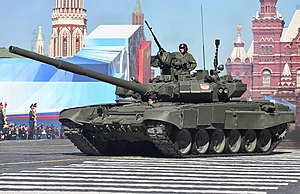T-90S
| T-90 | |
|---|---|

Russian Army T-90A tank on display during parade festivities in May 2013.
|
|
| Type | Main battle tank |
| Place of origin | Russia |
| Service history | |
| In service |
1993 (T-90) |
| Used by | See Current operators |
| Wars |
1999 invasion of Dagestan Syrian Civil War |
| Production history | |
| Designer | Kartsev-Venediktov |
| Manufacturer | Uralvagonzavod |
| Unit cost | USD 2.5 million in 1999, USD 2.77 – 4.25 million in 2011 (varies by source) T-90MS: USD 4.5 Million |
| Produced | 1992–present |
| No. built | 3,200+ |
| Specifications | |
| Weight | 46 tonnes (45 long tons; 51 short tons) (T-90) 46.5 tonnes (45.8 long tons; 51.3 short tons) (T-90A) 48 tonnes (47 long tons; 53 short tons) (T-90MS) |
| Length |
9.63 m (31 ft 7 in) 6.86 m (22 ft 6 in) (hull) |
| Width | 3.78 m (12 ft 5 in) |
| Height | 2.22 m (7 ft 3 in) |
| Crew | 3 |
|
|
|
| Armor |
Steel-composite-reactive blend vs APFSDS: 550-650mm, with Kontakt-5 = 800–830mm; vs HEAT: 650-850mm with Kontakt-5 = 1,150–1,350mm |
|
Main
armament |
2A46M 125 mm smoothbore gun with 43 rounds (T-90) 2A46M-5 125 mm smoothbore gun with 42 rounds (T-90A) |
|
Secondary
armament |
12.7mm Kord Heavy machine gun, 7.62mm PKMT |
| Engine | V-84MS 12-cyl. diesel (T-90) V-92S2 12-cyl. diesel (T-90A) V-92S2F (T-90MS) 840 hp (618 kW) for V-84MS 12-cyl. diesel engine 950 hp (736 kW) for V-92S2 12-cyl. diesel engine 1130 hp (831 kW) for V-92S2F (T-90AM&T-90MS) |
| Power/weight |
18.2 hp/tonne (13.3 kW/tonne) (T-90) |
| Suspension | Torsion bar |
|
Operational
range |
550 km (340 mi) (without fuel drums) |
| Speed | 60 km/h (37 mph) |
1993 (T-90)
9.63 m (31 ft 7 in)
Steel-composite-reactive blend
2A46M 125 mm smoothbore gun with 43 rounds (T-90)
18.2 hp/tonne (13.3 kW/tonne) (T-90)
The T-90 is a third-generation Russian battle tank that entered service in 1993. The tank is a modern variation of the T-72B and incorporates many features found on the T-80U. Originally called the T-72BU, but later renamed to T-90, it is an advanced tank in service with Russian Ground Forces and the Naval Infantry. The T-90 uses a 125 mm 2A46 smoothbore main gun, the 1A45T fire-control system, an uprated engine, and some vehicles thermal sights. Standard protective measures include a blend of steel and composite armour, smoke grenade dischargers, Kontakt-5 explosive-reactive armour and the Shtora infrared ATGM jamming system. It was designed and built by Uralvagonzavod, in Nizhny Tagil, Russia. Since 2011, the Russian armed forces have ceased any further orders for the T-90, and are instead anticipating the development of the T-14 Armata that is expected to enter service in 2016.
The T-90 has its origins in a Soviet-era program aimed at developing a singular replacement for the T-64, T-72 and T-80 series of main battle tanks. The T-72 platform was selected as the basis for the new generation of tank owing to its cost-effectiveness, simplicity and automotive qualities. The Kartsev-Venediktov Design Bureau from Nizhny Tagil was responsible for the design work and prepared two parallel proposals - the Object 188, which was a relatively simple upgrade of the existing T-72B tank (Object 184), and the far more advanced Object 187 - only vaguely related to the T-72 series and incorporating major improvements to the hull and turret design, armor, powerplant and armament. Development work was approved in 1986 and the first prototypes were completed by 1988. The vehicles resulting from the Object 187 program have not been declassified to this date, but it was the lower risk Object 188 upgrade that would be approved for series production as the T-72BU.
...
Wikipedia
